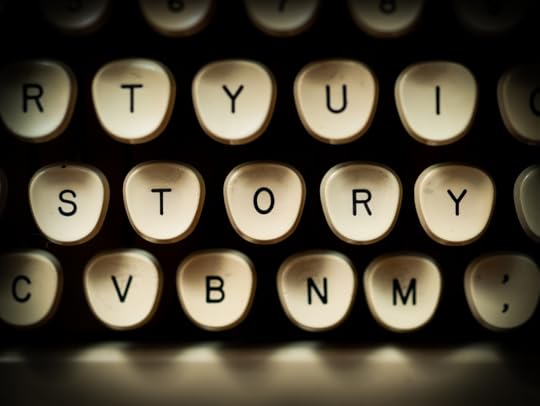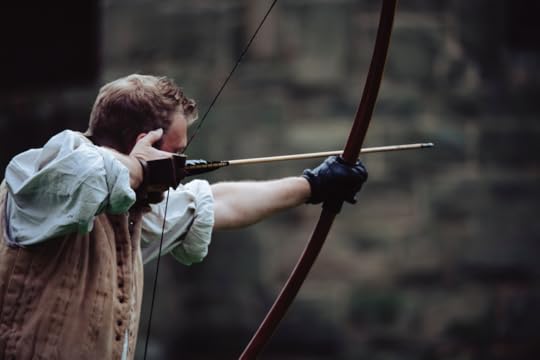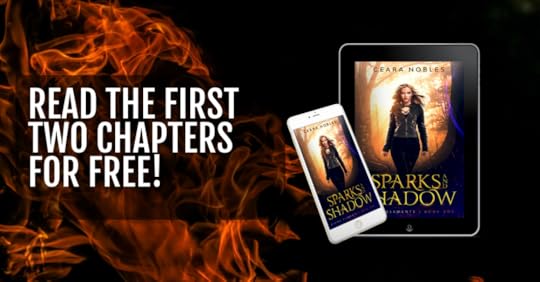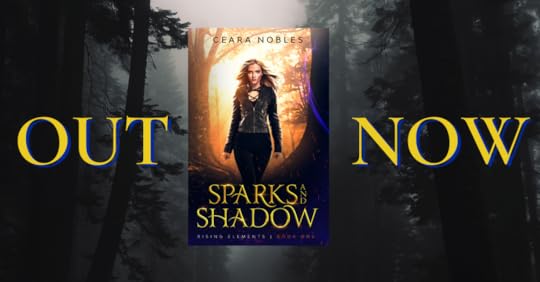Ceara Nobles's Blog, page 3
May 20, 2022
The Power of Storytelling [My Story]
There's a reason storytelling is one of the oldest forms of communication in the world. It's because it's incredibly powerful. Stories can entertain, educate, and engage us like no other form of communication can. And as writers, we have the ability to use stories to change people's lives. So let's use that power to its fullest potential and tell stories that matter!

Everyone loves a good story... especially me. My love of stories began when I was a child. Every night at bedtime, my little brothers and I would climb into my mom's bed and she would read aloud from the first Harry Potter book. I vividly remember the way I felt when she opened to the first page and we learned about an old man with a magic lighter and a half-giant who rode a flying motorcycle.
As I grew older, I fell in love with reading. I would lay on the floor in my bedroom for hours, listening to the Harry Potter books on tape. In the summers, my mom would take me to the library once a week and I would stagger to the front desk with a stack of books piled from my hands all the way to my chin. (Have you ever seen Cinderella? You know how Gus-Gus carried all those corn kernels in his arms? That's what I looked like.) I would read all the books in a week, return them, and repeat the same cycle.
But my love of story didn't stop with books. In my teenage years, I devoured everything story related. I watched all kinds of TV shows and movies, everything from anime to rom-com to action and adventure. I started writing my own stories and later creating my own little cartoon TV shows using The Sims to film.
When I say that story has changed my life, I mean it. As an adult, I started a career in customer service, where I fell in love with listening to other people's stories in the waiting room (I worked at a dentist's office). My love for storytelling eventually led me to a job as a hybrid customer service manager and copywriter. There, I learned how to use story to market products. I learned how the power of story can encourage people to buy a product that could change their lives.
And now here I am, in my current career as an author and freelance line editor, polishing other writers' stories and sharing my own stories with the world. And hopefully someday, my stories will support my family too.
Stories connect us all. They inspire us, make us laugh, and move us to tears. They help us understand the world around us and the people in it. And they can incite change – both big and small. We’ve seen the power of storytelling throughout history, and I believe that it is one of the most powerful ways to communicate. If you agree, I challenge you to start sharing your story with others. You never know where it might lead you!
May 13, 2022
5 Best Books for Authors
It's no secret that authors need to read. Reading is essential for honing our craft, understanding the industry, and keeping up with trends. But what are the best books to read if you're an author? I've put together a list of five books that I think every author should read. Whether you're just starting out or you're a seasoned pro, these books will help you improve your writing skills and knowledge of the publishing industry. So without further ado, here are my five picks for the best books for authors!
 1.
On Writing by Stephen King
1.
On Writing by Stephen King
If you want to be the best, you must learn from the best. There's no question that Mr. King is the KING of fiction. He is notorious for being very prolific and has written so many books that it's nearly impossible to keep track of them all. If you're looking for a great book that will give you tricks and tools of the trade along with snippets about the author himself, you won't want to miss this one.
2. Business for Authors by Joanna PennI've been reading a lot of Joanna Penn lately! She has an excellent series of books tailored toward self-published authors on a variety of topics (everything from writing to running a business to looking after your mental health as an author). Each book is short and easy to digest, with steps that you can put into practice immediately!
3. Structuring Your Novel by K.M. WeilandI have been following K.M. Weiland's blog since before I became a published author myself. She posts every week about how to become an author, and she has a super helpful series of books geared toward just that. Structuring Your Novel was the first one I read, and it had a big impact in the way I understood story and how I structure all of my books.
4. Dear Writer, You Need to Quit by Becca SymeBecca Syme is a genius in the author coaching field. I saw her at the 20Books Las Vegas conference last year and fell in love with her philosophy. She focuses on helping authors become more productive and avoid/overcome writer's block and burnout by focusing on individual personalities and strengths and weaknesses. Her 6-book series is aimed at helping writers identify their strengths and learn to use them!
5. Big Magic: Creative Living Beyond Fear by Elizabeth GilbertThis book is just... *chef's kiss*. If you're looking for something to light your creative fire and inspire you to chase your dreams, this is the book you've been waiting for. Elizabeth Gilbert is a master of weaving words and inspiring others to pursue their passion! I HIGHLY recommend this one on audio book. Elizabeth Gilbert herself reads it, and every time I listen to it, I feel excited and empowered and INSPIRED!
Final ThoughtsWhile I can’t promise that reading these five books will make you the next J.K. Rowling, they should help you improve your writing skills and understand some of the basics of being an author in today’s market. What do you think is the best book on writing out there? Let me know in the comments below!
May 6, 2022
How to Build a Fantasy World Readers Will Love
As a fantasy author, my favorite part about the process is creating my fantasy worlds. Setting is so important, especially in the fantasy genre, but creating a compelling and believable world can be tricky: you don't want your world to be so complex that readers get lost, but you also need to provide enough depth and detail to make it feel real.
If you're itching to escape into a fantastical world of your own, then I've got just the thing. Today, I’ll share the steps I took to create a fantasy world from scratch. It may seem like a daunting task, but with these simple steps, you'll be well on your way. So grab a cup of coffee (or your favorite magical beverage) and let's get started!
 Start with the basics
Start with the basics
You’ve got to start somewhere, so let’s answer some basic questions. What kind of world are you creating, and what are the main races and cultures that inhabit it? This might seem like a gigantic task, but it’s really not. Many fantasy worlds are loosely based on settings we have in the real world.
For example, my magical world of Faery is based loosely on the forests of Ireland that I visited a few years ago. I knew I wanted a forested land full of myth and magic, and the Fae are a huge part of Irish lore. Once I knew that much, it was a simple task to research and brainstorm from there.
Create a map of your world
This part of the process was really fun for me! It really helps to visualize the land you’re creating. There are lots of free map-building tools out there (just Google a few), but I used Campfire Pro to create my map and keep all the details straight. Once you have a generic idea of landscape features, you can break things down into regions and further explore the cultures in each region.
(All of this doesn’t have to make it into your book, by the way. No one likes a huge info dump! But the more you know as the author, the easier it will be to add small details into the story to really make the world come alive.)
Develop a backstory for your worldMore bainstorming, here we come! Do your world’s inhabitants believe in a deity? How was their world created? If it was created by a deity, is the deity still alive? Does he or she have an impact on the world?
I found that the best way to brainstorm this stuff is just to open a Word document and start typing. Don’t worry about what comes out; just write whatever comes to mind in a giant mess and see what happens. That’s how I came up with the entire premise for the world of Faery and the deity, Seraphine, who created it.
Describe the customs and traditions of your world's peopleNow that you know about the geographical data of your land and how it was created, it’s time to focus on the people or creatures who live there. What are the customs and traditions they’ve developed? What about their beliefs and religions? You can base this on something in the real world that you’re interested in, or you can come up with something completely new.
For example, my world of Faery is a large island in the sea. A trademark of my world is that everything is HUGE. The trees are the size of skyscrapers, and there’s a mountain with a giant waterfall that feeds water to the forest. At the top of the waterfall is Reya, where the queen and the five royal houses live. At the bottom of the waterfall is Thios, where the downworlders (AKA the commoners) live. The geography inspired this kind of literal hierarchy, and then it was simple brainstorming to ask myself, “What do the Reyans believe? What do the Thiosians believe? How do the Thiosians feel about living on the bottom? How does this affect their relationship with the royals?” One question leads to another and another until you’ve got thousands of words of back story about your world and the people who live there!
Create a cast of characters to inhabit your worldNow it’s time to hone in on the specifics. Think about specific characters that inhabit your world. What are their beliefs? Their trades? Their past experiences? These can be characters that will be featured in your story or just side characters that will help you flesh out the way the world works.
For me, I quickly came up with a few characters who became crucial to my story: Aki, the former royal who now lives below and leads the Thiosians in a rebellion against Reya. Mina, his loyal friend and inventor who creates gadgets for the rebels. Gideon, first lieutenant and Thios’s resident drunkard who is surprisingly capable. And lastly, Shadow… the rebellion’s spymaster and wolf shifter with a shady past and even shadier motives.
Final ThoughtsIf you're like me and love getting lost in a good fantasy world, then you'll really enjoy creating your own. It's an incredibly fun process, and I have loved sharing my world with my readers. So what are you waiting for? Start building your world today!
What's your favorite fantasy world that you've read? Let me know in the comments – I'm always looking for new worlds to explore.
April 29, 2022
5 Steps to Hook Your Reader from the First Page
As an author, it is my duty to hook you from the get-go. No matter how good my book may be, if I can’t keep your attention, chances are you won’t make it past the first chapter. And trust me, I don’t want that. So today, I’m going to give you five tips on how to hook your audience from the first page. Keep in mind that these techniques can be used in works of any genre—whether it be a crime novel or a romantic comedy. Let’s jump right in!
 1. Start with a bang
1. Start with a bangHave you ever heard the writing gurus say, “start in the middle?” I don’t necessarily agree with that advice. Sometimes it can confuse your readers if you drop them in the middle of a situation without giving them any opportunity to care about it. But the core of the advice is true—a great way to start your story is with action. Many writers make the mistake of loading the first few chapters with a TON of background information about the world, the characters, and the stakes. It’s great to establish those, but you don’t need to do it right at the beginning. Instead, try adding in bits of information to an action-y scene to hook your readers without bogging them down.
In my book, SPARKS AND SHADOW, the first chapter is a bike race between my main character and her arch nemesis. In that short sequence, I tell my readers a lot about Everly’s personality and her background as a bike messenger/delivery person. I also introduce the reader to Everly’s supernatural power—that she can see monsters.
Another example that I’ve read recently is Sarah J Maas’s HOUSE OF SKY AND BREATH (HOSAB). In the first chapter, we’re dropped into the middle of a daring rescue attempt that goes horribly wrong. It’s packed full of action and little bits of information that keep the reader guessing.
2. Establish the stakesOh, the stakes. You’ve probably heard writing gurus clamoring on about raising the stakes for your characters. If you want your readers to care about your story, you HAVE to tell them the stakes. And then you have to raise those stakes, over and over and over again! When you do that, BAM. You have a story.
In chapter one of my book, the stakes are established right away. Everly has to win this bike race in order to get the money for the delivery, and to beat Peter because he embarrassed her. If she fails, Peter wins again AND he gets the money. Not only that, but we learn at the end of the chapter that there are bigger stakes involved. Everly must ensure that the monsters in Seattle don’t realize she can see them—and her bike delivery puts her right in the middle of them.
In HOSAB, the stakes are life and death right in chapter one. If the character can’t successfully rescue her brother from the death camp, they’ll both die. The stakes can’t get much higher than that.
3. Show your character's unique voiceYour main character (or characters) should be the driving force of your story, so naturally, you need your reader to care about them. How do you do that? By making them feel real. Establish their unique voice in chapter one and your reader will start to care about what happens to them.
In my book, Everly’s snarky attitude comes through on the first page in her banter with Peter and her thoughts about the world around her. She’s a tough, take-no-crap character, and that’s clear from the beginning.
4. Make the world feel aliveIt doesn’t matter if your story is set in the suburbs, a sprawling city, or a fantastical world—it needs to feel alive for your readers. A world is filled with people and systems and economies. You don’t need to explain it all in the first chapter, but you can certainly hint at it. Drop little bits of information that will intrigue your readers and encourage them to keep reading!
The first part of SPARKS AND SHADOW takes place in Seattle, Washington, but this isn’t the city you know. Everly sees the city as a gritty, dog-eat-dog (or in this case, monster-eat-human) world, and that comes through in the first couple chapters as we learn more about her and her situation.
5. Don't hold back - hook your readers from the first page!Your first page is SO IMPORTANT. Not only is it the first impression your readers get of your world, your writing, and your characters, but many potential readers will continue a book or put it down based on that first page. Feel the pressure yet? I certainly do! Don’t wait to drop the bomb (whatever it is) until the end of the first chapter. Is there a way you can do it on page one? Is there a tidbit of information you can drop that will hook your reader from the first page? DO IT!
I packed a ton of important information into my first page. The reader learns that monsters are real, they’re in Seattle, and my main character is the only one who can see them.
You can check out the first page here if you want to see how I did it:
Final ThoughtsMy goal as an author is to grab my readers from the beginning and never let them go. By following these five simple tips, you can create a story world that feels alive and allows your characters’ unique voices to shine through. So don’t hold back—start your novel with a bang and see where it takes you!
Have you read a book lately that hooked you from the beginning? Please share in the comments below – I’d love to hear about them!
April 22, 2022
The Pros and Cons of Self-Publishing
Self-publishing has grown in popularity over the past few years. With the ease of self-publishing platforms and the rise of indie authors, it's no wonder why more and more people are choosing to publish their work themselves. But is self-publishing the right choice for you? This blog post will discuss the pros and cons of self-publishing to help you decide if it's right for you.
 What is self-publishing and how does it work?
What is self-publishing and how does it work?Self-publishing is exactly what the name describes: YOU become the publisher of your own book. Every task in the publishing process falls on your shoulders. Writing, editing, cover design, distribution, marketing, and long-term business decisions. If that sounds like a lot, it’s because it is. With great responsibility comes great rewards, though… especially if you’re willing to put in the work!
I could write a whole blog post (or a hundred) about how the process works, but there are entire courses out there to walk you through it. I’m here simply to discuss the high-level pros and cons so you can determine if it’s the right path for you.
The ProsControl over the publishing process: As the publisher, you have complete control over the publishing process. Instead of writing the book and handing it off to a team who may or may not make good decisions, the ball is completely in your court. This is terrifying but also very liberating.
When I finished my first book, I wanted to pursue traditional publishing. After spending several months in the query trenches and interacting with agents, I started doing some research on self-publishing. I wasn’t sure it was the right fit for me, but I dove in anyway. And you know what? I don’t know that I’ll ever give that control back. I love making all the decisions for my story and wearing lots of different hats during the process. It’s a lot of responsibility, but it’s also a lot of FUN!
More creative freedom: Because I’m the one publishing my own book, I have ultimate freedom over what I’ll write and how I’ll present it. In traditional publishing, authors have to stay within the box that big publishers have created in order for their books to succeed in the market. Granted, top publishers know what sells, but making that decision myself allows me the freedom to write to market… or not! I can write a book for a niche audience that a top publisher would never pursue and still make great money.
Faster turnaround time: If you’ve looked at the top self-publishing authors in the market, you’ll probably notice that many of them have crazy fast turnaround time for their books. Some of them release books as fast as once a month. Cami Checketts, one of my clients for my line editing business, writes a book every two weeks. When you have control over project timelines, you can produce as fast or as slow as you want. No more being stuck to a one- or two-book a year schedule!
Higher royalties: Obviously, if you do all the work, you get paid more. With Amazon, you can get up to 70% of your ebook’s value in royalties. With traditional publishing, authors typically get 10-20% per book. That’s a substantial difference in pay check, especially if you’re selling a lot of books!
The ConsLack of support: Self-publishing can be a lonely job sometimes. If you want support, you have to hire it out, and it can sometimes be difficult to find the RIGHT support for your book. Learning the business yourself can be costly, especially when you’re first starting out. On my most recent book release, I ended up spending about $4,000 between production costs and marketing. If you don’t have that money up front, it can be difficult to stomach the idea. My line editing job completely funds my author career for now as I’m building my back list.
Marketing is up to you: This is becoming true for more and more publishers, but in self-publishing, the marketing (and its associated costs) all fall on you. This can be as expensive or as cheap as you want to make it, but many of the big-name self-publishing authors drop tens of thousands a month to keep their books advertised and at the top of the bestseller lists. Crazy to think about!
Difficult to stand out: Amazon publishes thousands (if not tens of thousands) or self-published books every day. When you join the self-publishing crowd, it can be difficult to stand out in those massive numbers without a big publishing house supporting you. It takes time, practice, and a LOT of patience to build a career this way!
Final ThoughtsSo, is self-publishing right for you? That depends on your goals and what you’re willing to put into it. If you want more control over the publishing process, more creative freedom, a faster turnaround time, and higher royalties, then self-publishing may be a good option for you. However, keep in mind that there are some drawbacks – such as the lack of editorial and design support and the burden of marketing costs. Do your research before making any decisions so you know exactly what you’re getting into. Looking for a good place to start? Check out the 20Booksto50K group on Facebook. There’s a goldmine of information there for writers who are looking to self-publish!
Have questions about self-publishing? Let me know in the comments below!
April 15, 2022
Character Interview - Gideon [SPARKS AND SHADOW]
If you've read my book, you know that Gideon is a Fae warrior who loves whiskey and never wears shoes. But have you ever wondered about his past?
Today, I'm sharing a little deleted scene between him and Everly as they practice shooting in a clearing. I hope you enjoy it!

Thwump. Thwump.
I lowered the bow, tossing Gideon a satisfied grin.
“Not bad, chickie,” he conceded. “But don’t get overconfident now. You still have a long way to go.”
I quelled the urge to stick my tongue out at him. A long way to go? I’d started shooting a bow only a week ago and I was practically a master already. Bria’s thugs better watch out.
Gideon walked across the clearing to pull my arrows out of the stump we were using as a target. I watched the dappled sunlight play across his broad shoulders. His pointed ears stuck out of his mussed hair.
As he returned to my side and picked up the bow, I found myself giving in to my curiosity. “Can I ask you some questions, Gideon?”
He glanced at me, his hazel eyes twinkling. “Could I stop you if I tried?”
I pretended to think about it. “Probably not.”
“Then ask away, darlin’.” He pulled back the string, his shoulders relaxing in a visible breath, and let the arrow fly.
It struck the target with another thwump. Bullseye. Of course.
“I know your sister is gone,” I said slowly. “But what happened to your parents?”
If Gideon was bothered by my question, he didn’t show it. “They died a long time ago. My sister and I were alone for many years before the Schism.”
“Were you close with them?”
His mouth tilted up in a crooked smile. “Oh, yeah. My sister and I ran them ragged with our tricks. My father used to throw us over his shoulder, one on each side, and toss us into the house for dinner every night.” He paused and shot me a full grin. “That is, if he could catch us.”
I smiled at the thought of a tiny Gideon running around with his sister. What was he like before his sister died and he became the never-serious, always-drunk Fae I’d come to know? “They sound great.”
“They were.” Gideon let another arrow fly and didn’t even look when it hit the target. Bullseye. “What’s with the questions?”
I shrugged. We were days away from taking back the gate so I could go back to Seattle, and now that we were here, I found myself burning to know more about the Fae I’d spent the past six weeks with. We’d been so busy preparing for this moment that I hadn’t taken the time to ask any of them these questions. Once I went back to Seattle, I’d never get the chance again.
“Just curious, I guess,” I answered, avoiding Gideon’s gaze.
Gideon clapped me on the shoulder. “Thios is growing on you, isn’t it, chickie? It’s okay; you can admit it. You want to live here in the trees with the monsters forever.”
I shrugged him off with a reluctant laugh. “Monsters?”
“That’s what you thought we were in the beginning, right?”
Who had told him that? I didn’t think I had mentioned those words aloud. Even if I had, I would never admit to it. “I don’t know what you’re talking about.”
“Sure you don’t.” Gideon grinned.
I took the bow from him and nocked an arrow, ignoring Gideon’s cheeky laugh. Maybe Gideon and the others had grown on me a little, and maybe I had reluctantly grown to like Thios. So what? It didn’t change the fact that I had to go back to Seattle.
But something in the way Gideon nudged me with his shoulder made my cheeks warm. Thios—and the Fae who lived here—wasn’t so bad after all.
SPARKS AND SHADOW is available now! Click here to order your copy today.
April 8, 2022
How To Win Your Writing Retreat [Steps to Success]
If you're a writer, you might've heard the term, "writing retreat." If you think it sounds like a fancy place writers go to sip tea and work on their novels, you'd be right...and wrong.

Writing retreats have one goal: to get. writing. done.
That can happen at your own house (staycation, anyone?), a camp trailer in the woods, your grandma's house, or in a fancy hotel or airbnb. As long as it's a place you can devote a period of time to writing with no distractions, you're golden.
I've been wanting to do a writing retreat for some time now, but I've never found the opportunity to do it. But I'm behind on my draft for book 2 in my Rising Elements series, and this week was my daughter's spring break from school.
So I did the thing.
I called my angel mother-in-law and arranged for my daughter to spend a few days at her house. Then I booked an airbnb nearby and voila! Writing retreat achieved.
I came into this week with the lofty goal of writing 10,000+ words per day and smashing my goal of getting caught up on my draft.
As you can probably guess, things didn't go according to plan, haha!
But I did accomplish A LOT! And I'll share exactly how much I accomplished after I go over the 3 steps I followed to have success on this writing retreat.
Step 1: Set the Stage
Whether you're doing your writing retreat at an airbnb or at home on your couch, you need to set the stage if you want to have success. The whole purpose of a writing retreat is to write with zero distractions. So now it's time to eliminate the distractions from your space. Turn off the TV, put your phone on do not disturb, and make a commitment to ignore everything else--at least during your writing sprints.
Another part of setting the stage is making sure that your writing stage is set for you to write a metric ton of words. If you're a plotter, make sure your outline is cleaned up and ready to go, because you won't have time in the middle of a writing sprint to figure it out. If you're a pantser... well, may the writing muse be with you.
Just kidding. Even if you're a pantser, you can take a minute to think about the scene you'd like to write before a writing sprint starts and jot down a few notes--or just keep them in your mind so you have a generic roadmap to follow once you start writing.
Step 2: Know Your Limits
Remember how I mentioned my 10,000 words per day goal? That was me NOT knowing my limits. Listen, even if you set aside 12 hours per day to write, that doesn't mean you can mentally or physically WRITE for that amount of time. (Maybe some writers can. If that's you, YAY! But it's not me.)
I found that I could work in 2-hour chunks, and then I needed a break. So I did a few two-hour sessions throughout the day and took decent-sized breaks in between where I ate lunch, checked emails, and worked on other work-related projects.
During my two-hour writing sessions, I did four 25-minute writing sprints. 25 minutes on, 5 minutes off. On my 5-minute breaks, I got up and stretched, moving around until my body felt more limber. The longer I sit in a chair, the more stiff I get!
I found out through trial and error that 6,000-ish words per day is my sweet spot. This left plenty of time to work on other work projects, relax, and rest my eyes from the screen. For some, that might seem like a lot, but for this busy mama who hustles just to get 2,000 words a day, that's HUGE!
Step 3: Get your butt in the chair and WRITE!
This is the hardest part. It's time to tune out the distractions, shake off the procrastination, and DO THE WORK.
I found myself continually getting distracted during my writing sprints. I would start thinking about what to eat for dinner or what my daughter was doing with Grandma or the work emails landing in my inbox. I had to keep redirecting my thoughts back to my manuscript, and it took some discipline, but guess what? IT WORKED!
My Takeaways
This writing retreat was such a success for so many reasons. I had 4 whole days to work with no interruptions, and that was worth its weight in gold. I may not have written 10,000 words a day like I'd originally planned, but I did write almost 25,000 words in that 4-day period. Not only that, but I had the chance to read some excellent craft books, get caught up on work projects that had been sitting on the back burner (audiobook fans, where you at? Fun news coming soon!!), and spend time ALONE.
I'm an introvert by nature, but these days I never spend time alone. It was really nice to spend a few days where no one needed me. No one (except myself) asked me for a snack every five minutes. I had zero responsibilities except to my writing, and that was liberating.
My overall takeaway? I'll be doing a writing retreat again very soon.
What are your thoughts about writing retreats (or any kind of retreat, really)? Have you ever done one? Would you consider it? Let me know in the comments below!
Until next week!
April 1, 2022
SPARKS AND SHADOW - First Two Chapters [FREE]
The first book in the Rising Elements series, SPARKS AND SHADOW, has been out for almost a month! It has been my biggest release yet, and it even jumped to #37 in the top 100 for its category.

To celebrate, I thought it would be fun to share a snippet with you. But I couldn't stop there, so I decided to share the FIRST TWO CHAPTERS for free!
Here's the blurb:
Seattle is full of Fae, and I’m the only one who can see them.I’ve spent the last 17 years (AKA my whole life) pretending I can’t see the creatures who disguise themselves as humans. I thought my biggest problem was competing with my arch nemesis and earning money to get my best friend off the streets of Seattle.That is, until I stumble into a warehouse full of the creatures I’ve spent my life trying to avoid.Next thing I know, I’m being dragged through a brick wall and into a world that is definitely not Seattle. If I want to get home, I have to join a band of revolutionaries and stay alive long enough to get back through the portal before war breaks out.The problem? The monsters I’ve spent my life avoiding aren’t really monsters, and I feel more at home with them than I ever did in the human world.Sparks and Shadow is a modern, action-packed YA portal fantasy featuring Fae mythology, magic, and slow-burn romance. This is the first book in the Rising Elements series.
Click HERE to claim your copy of the first 2 chapters for free! And don't forget to leave a copy below and let me know what you think. Does it make you want to read more?
If you love it and want to read the whole thing, it's only $3.99 on Amazon Kindle--or FREE if you have Kindle Unlimited! Click HERE to purchase your copy.
March 25, 2022
Writing Update: March 2022
I have a confession to make... I completely missed my February update. *face palm*
Between release day prep and drowning in editing projects, it slipped off my radar. Whoops!
But it's a new month! And it's time for a March writing update! Here we go.

Welp, it's official. Everly's first book is out in the world, and I'm so excited to announce that it was my biggest release yet! I'm so glad her story has resonated with so many of you. I've gotten so many fun reviews! Here are a few of my favorites:
"Fantastic fae, marvellous monsters, magic, great characters, intriguing story with twists and turns, and an end that will leave you wanting more."
"Escapist, Thrilling and Beautifully set in the land of the Fae, Sparks and Shadows is promising to be an enticing series!"
"I read through this book so quickly and before I knew it I was at the end and cursing myself for reading so quickly."
"This was a fast-paced and wonderfully magical escapist read! I loved getting lost in this world! Who wouldn’t want to hang out in a fancy tree house in the land of Faery, eat scrumptious scones with honey butter, and drink delicious coffee!?"
CURRENT WORD COUNTCurrent word count: 469
Target word count: 65,000
Guys, I'm so behind already. The first draft is due 5/1, and it's clear that I have a LOT of work to do! The good news is, the whole book is outlined and ready to go, my scenes are fleshed out, and I've scheduled a 4-day writing retreat to pound out some words and get caught up. I'll be locking myself in an Airbnb for 4 days straight with no distractions and I'm determined to knock this draft out. I'll let you know how it goes!
WRITING THOUGHTSYou know, a lot of authors say that book 2 is a beast, and I can already see why. I am so in love with book 1, and I really want to make sure that book 2 lives up to the story I've envisioned in my head. But can I do it? Am I capable of two great stories in a row? Imposter syndrome is real, guys.
But you know what? I already know the cure. WRITE, WRITE, WRITE. So next week, I'll spend 4 days with my phone on airplane mode in a remote location. No internet, no toddler (I love you, Annabelle!), and no distractions.
I was listening to a podcast episode a few weeks ago from Neil Gaiman. He talked about how he gets words done when he's behind or really needs to finish a draft. He said he books a sketchy hotel room somewhere and locks himself inside. While he's there, he gives himself permission to do 2 things: write, or do nothing. He's not allowed to read, phone a friend, or turn on the TV. This is crazy effective because he has a choice whether he will write, but doing nothing gets boring real quick.
So that's the approach I'm taking with this upcoming writing retreat. ;) I'll let you know how it goes! By the time I do my next writing update, I should be finished with my first draft! I'll probably do a blog post specifically on the writing retreat results before that, though, so keep an eye out.
That's all for now. Talk to you next week!
March 18, 2022
Top 5 Self-Publishing Mistakes I've Made (So Far)
When I first dipped my toe into the ocean that is self-publishing, I thought to myself, "How hard could this be?"
You write a book, you put it on Amazon, and you become a millionaire overnight.
Right?
If only that were true.

Okay, so I wasn't that naive. The truth is, I never planned on self-publishing my first book. I always thought I'd sell it to an agent, who would sell it to one of the top 5 publishing houses, who would then sell a million copies and I would become a millionaire. (I'm sensing a pattern...)
When I realized traditional publishing wasn't the route for me, I faced a choice: let my story disappear, lost to the depths of the internet wasteland... or self-publish.
So I started doing my research.
Even with my preparation, though, I've made MANY mistakes since I started my publishing journey. By writing about them here, I hope it will 1) stop me from ever making the same mistakes again, and 2) prevent someone ELSE from making those same mistakes.
Without further ado, let's take a look at the Top 5 Self-Publishing Mistakes I've Made (So Far).
#1: I didn't research my genre.
I knew what kind of book I had written. It was clean romantic suspense. But before I went through all the trouble of commissioning a cover and spending hours finding the perfect keywords on Amazon, I wish I had researched my genre.
Knowing the genre isn't enough. If you want your book to be seen by as many people as possible, you must have a firm grasp on what the market is doing right now, TODAY, in your book's genre.
I never looked at top-selling book covers in my genre. (That probably would've changed the design I chose for my series.)
I never researched common tropes that are super popular right now. (That might've changed the edits I made in my final drafts.)
If you're considering the self-publishing route, I IMPLORE you. Do your research first. Make sure your book fits into the category you're trying to sell it in. Readers can smell an imposter (AKA me) a mile away!
#2: I didn't focus on growing my social media presence.
When it comes to marketing these days, social media is king. There's no doubt about it.
Even though I understood that and even created my own author Instagram and Facebook pages, I only updated them haphazardly. (In fact, I'm STILL working on this one.)
When I did post, I didn't engage with my audience in the right way. I wasn't authentic with my captions, and there was ZERO cohesion in my content.
Not only that, but I didn't actively engage with my audience and become a member of the community in order to organically grow my follower count.
Whether you're publishing now or two years from now... START YOUR SOCIAL MEDIA PRESENCE. It's vital in getting the word out about your book!
#3: I didn't plan a proper book launch.
Don't even get me started on book launch strategies. There are a million theories on the best way to launch a book and boost your sales.
I didn't do any of them.
Okay, I tried, but it wasn't well thought-out or well-executed. It resulted in decent sales (most of them from family friends) that have slowly grown over time, instead of a big boost in sales on release day.
Take the time to research book launch strategies WELL BEFORE you get close to release day. Write down your strategy, start implementing early, and you'll see much more success with your launch!
#4: I skimped on advertising.
I launched Dual Innocence, the first book in my ESI series, and waited for the sales to start rolling in.
Naturally, they didn't.
So I threw up some Facebook and Instagram ads, spending way too much money without thinking about the intent behind them.
Still no result.
Then I decided to try my hand at Amazon ads.
I ended up spending more than double the amount of my return. *face palm*
On top of that, I never even explored other advertising avenues, like local book fairs and events, radio appearances, book signings, etc.
Advertising your release is SO important if you want new people to find you, but it's important to be SMART about the decisions you make. If you go into the process with only a vague strategy and very little research, you'll end up spending more than you make. Nobody wants a negative ROI.
#5: I rushed the process.
Have you read my last post about Legacy Exposed, book 3 in the ESI series? I've been calling it my personal Mt. Everest.
Why, you ask?
Because I rushed the publishing process. I thought I could write, revise, rewrite, and re-revise, and finally publish a book... in 3 months. But I was new to writing professionally and VERY new at self-publishing. The truth is, just because self-publishing allows you to rapid-release your books, it doesn't mean you should.
Some authors can release a new book every other month, but most of them didn’t start that way. It took them years and dozens of books before they reached that point in their careers and creative process.
There you have it! Those are the 5 self-publishing mistakes I've made since releasing my first book. And trust me, they won't be the last. Every day I'm learning and growing, and that's what this journey is all about.
If you're an author, have you made these same mistakes? Or DIFFERENT mistakes? Let me know in the comments below! Let's talk about it.



